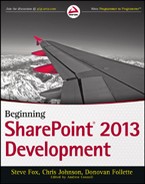DEVELOPMENT MODELS AVAILABLE IN SHAREPOINT 2013
In Chapter 2 you learned about the new application model for SharePoint solutions. This new model differs both in architecture and capability from traditional full-trust solutions offered in SharePoint 2007 and SharePoint 2010. As you start developing solutions for SharePoint 2013 you need to decide which of the following two models best suits your needs:
- A full-trust solution
- A new SharePoint application
Each has its respective pros and cons and you must carefully weigh which will suit your purposes best. One of the driving design decisions behind SharePoint applications was to provide a development model that was agnostic to whether the application was being used in SharePoint on premises or to Office 365 in the cloud. This point is extremely important to keep in mind as you decide how to build your application, and you are advised to seriously consider future plans for using SharePoint Online. Your organization might very well want to move to SharePoint Online in the coming years and will need many of its apps to go with it.
Although both the older full trust–style apps and the newer SharePoint applications offer some of the same capabilities, they differ in several areas. Table 6-1 summarizes some of the high-level components, or building blocks, that each offers.
TABLE 6-1: Full Trust Solutions versus SharePoint Applications
| COMPONENT | SHAREPOINT APPS | FULL TRUST SOLUTION |
| Web Parts | X | |
| App parts | X | |
| ASP.NET server controls | X | |
| ASP.NET user controls | X | |
| List and library templates | X | X |
| Content types | X | X |
| Event handlers | X | |
| Remote event receivers | X | |
| Pages and page layouts | X | |
| Files | X | X |
| Master pages | X | |
| Ribbon and list actions | X | X |
| Workflows | X | |
| Apps for Office | X | |
| Custom JavaScript list view renderings | X | |
| Custom JavaScript column renderings | X |
All SharePoint 2013 solutions are made up from a combination of one or more of the preceding building blocks. Typically, a solution built on SharePoint consists of three high-level application layers, not unlike solutions built with other technologies:
- User interface
- Logic
- Data storage
The developer’s task is to decide what SharePoint components best fulfill the requirements for each of the preceding application layers. A solution might, for example, mean using a Web Part for display purposes, an event receiver for processing and logic, and a list for storing and managing the solutions data. These basic architectural decisions don’t change based on your decision to build a full-trust solution or SharePoint application. You must still map your requirements to each of the capabilities these models provide to ensure it is suitable for your needs.
